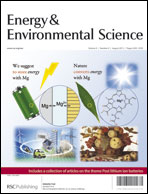Room-temperature stationary sodium-ion batteries for large-scale electric energy storage†
Abstract
Room-temperature stationary sodium-ion batteries have attracted great attention particularly in large-scale electric energy storage applications for renewable energy and smart grid because of the huge abundant sodium resources and low cost. In this article, a variety of

- This article is part of the themed collection: Post lithium ion batteries

 Please wait while we load your content...
Please wait while we load your content...